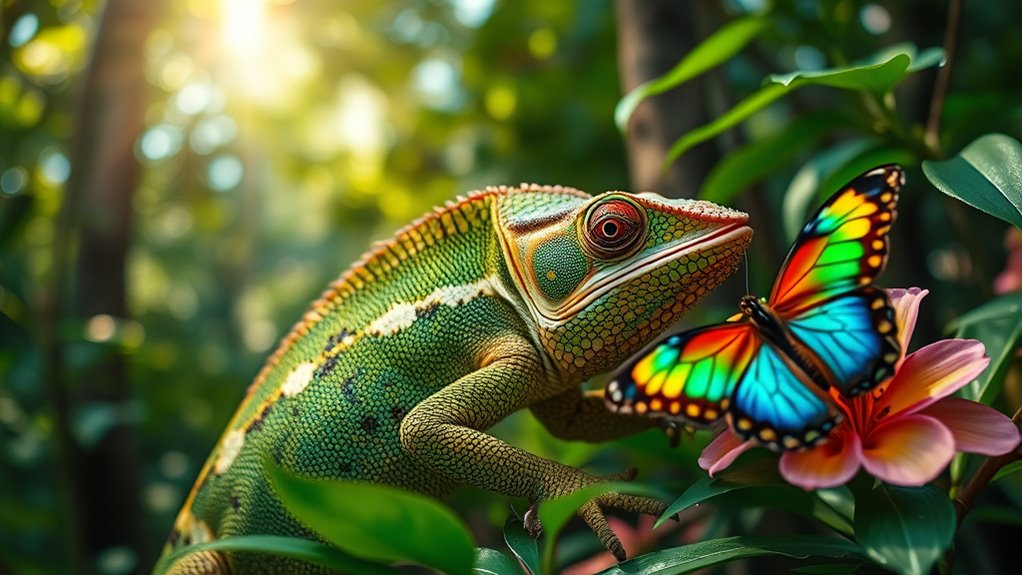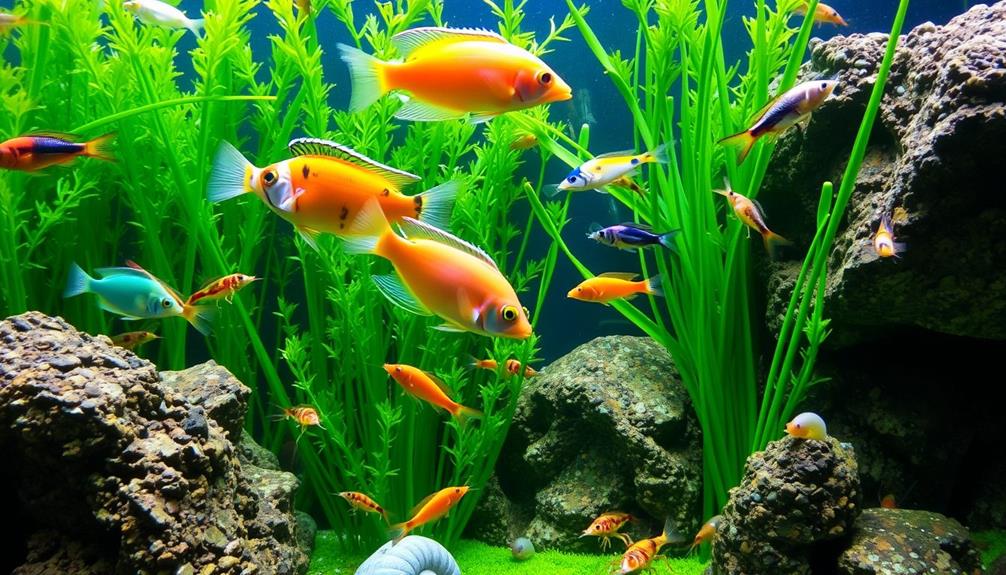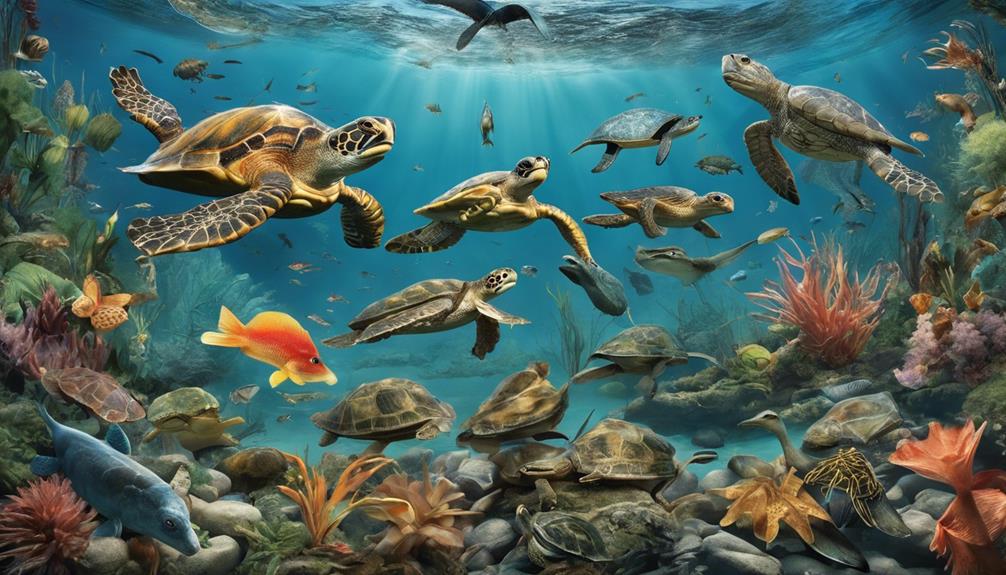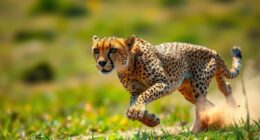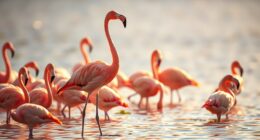Animal camouflage is a fascinating survival strategy where species adapt their appearance to blend into their surroundings. Techniques like background matching help them hide, while disruptive coloration breaks up their outlines. Creatures like chameleons and flounders display incredible color changes for concealment. This natural defense mechanism has inspired human applications, particularly in military gear. If you're curious about the various tactics and adaptations in the animal kingdom, there's so much more to discover.
Key Takeaways
- Camouflage, or cryptic coloration, enables organisms to evade predators by mimicking their surroundings through color and pattern adaptations.
- Animals employ various tactics like background matching and disruptive coloration to blend in or confuse observers, enhancing survival.
- Color production involves biochromes, structural coloration, and specialized cells like chromatophores for rapid changes in appearance.
- Examples include flounders matching the seafloor and chameleons altering colors for concealment and communication.
- Camouflage has evolutionary significance, influencing species adaptations and informing human applications in military and design contexts.
Definition and Purpose of Camouflage
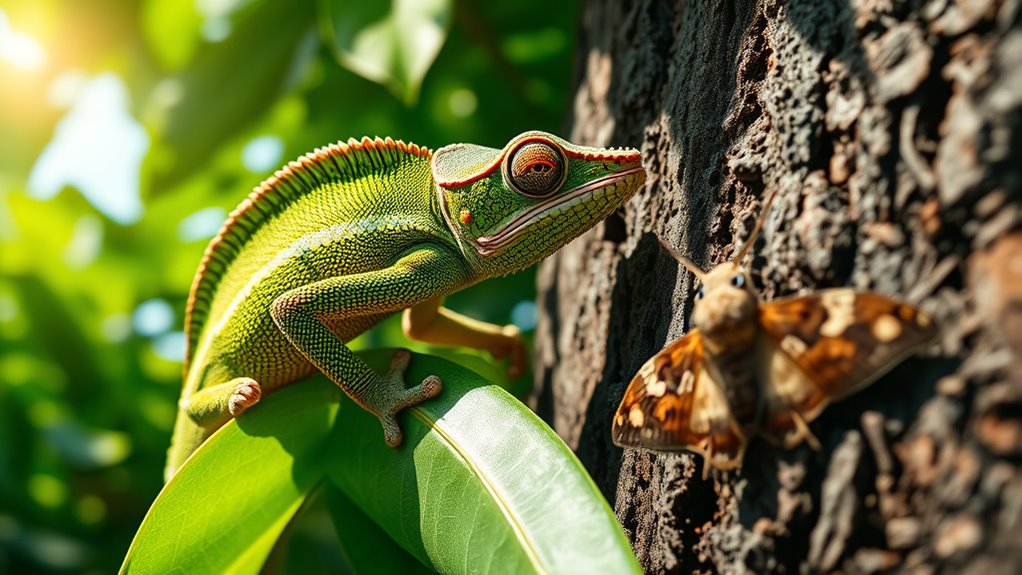
Camouflage, often referred to as cryptic coloration, serves an essential purpose in the animal kingdom by helping organisms disguise themselves from predators and prey. This defense mechanism allows you to blend seamlessly into your environment, enhancing your chances of survival.
The effectiveness of camouflage depends on your physical characteristics, like color, pattern, and movement. By employing techniques such as background matching, you can mimic the colors and patterns of your surroundings.
Additionally, disruptive coloration helps break up your outline, making it harder for predators to spot you. By masking your location and identity, you increase your likelihood of evading capture and successfully hunting, thereby playing a crucial role in the predator-prey dynamics of your ecosystem.
Types of Camouflage Tactics
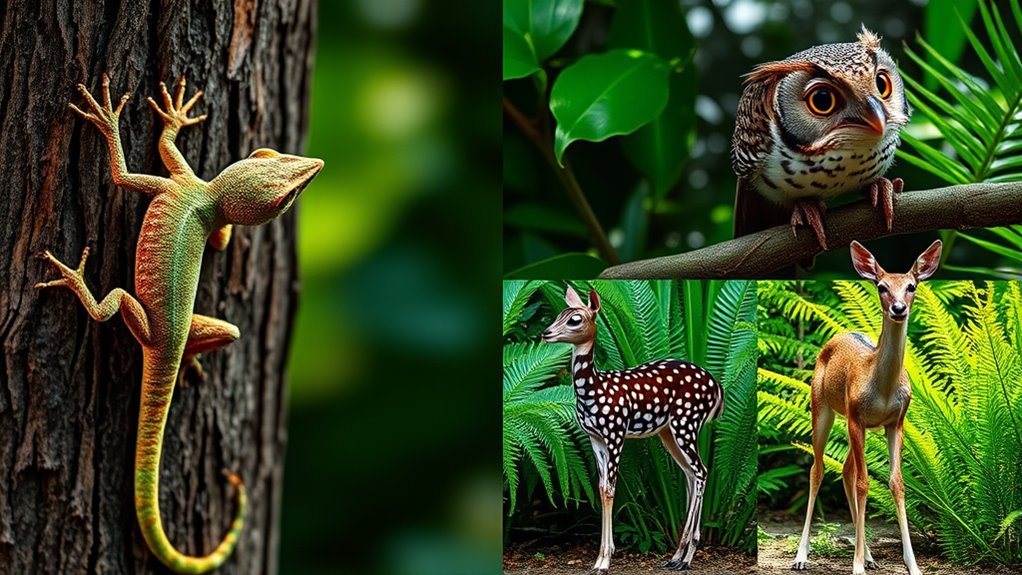
In nature, various tactics allow animals to blend into their surroundings and evade detection. Background matching is a common strategy, where an organism's colors and patterns mimic the environment, making it hard for predators or prey to spot them.
Animals employ background matching to blend into their environments, making it challenging for predators to detect them.
Disruptive coloration takes this a step further, using contrasting patterns to break up an animal's outline and confuse observers.
On the other hand, warning coloration, or aposematism, employs bright colors to signal danger, deterring potential threats, as seen in the monarch butterfly.
Finally, mimicry allows species to resemble other objects or creatures for protection, like walking stick insects mimicking twigs, or for hunting, as seen in aggressive mimicry among certain fish.
Examples of Camouflage in Nature

You might be surprised by how many animals use natural blending strategies and mimicry to survive in the wild.
From deer and squirrels hiding in forest shadows to flounders matching the ocean floor, these tactics are fascinating.
Let's explore some incredible examples of how these creatures conceal themselves and deceive predators.
Natural Blending Strategies
Many animals have evolved incredible natural blending strategies that help them evade predators and thrive in their environments. For instance, deer and squirrels use earth-toned fur to blend seamlessly into forests and grasslands, enhancing their chances of survival.
The flounder showcases remarkable camouflage, matching the speckled patterns on its skin to the seafloor, making it nearly invisible.
Walking leaf insects take disguise to another level by mimicking actual leaves, even swaying gently to enhance their concealment.
Meanwhile, dresser crabs cleverly decorate their shells with local materials, blending seamlessly with their surroundings.
These examples illustrate how animals use camouflage coloration and patterns on their skin to stay hidden and avoid detection in the wild.
Mimicry and Deception Techniques
While some animals rely on blending into their environments, others use mimicry and deception to confuse or deter predators.
For instance, walking stick insects mimic twigs, effectively disappearing in their natural habitat. The leaf-tailed gecko's flat body and coloration allow it to resemble leaves, keeping it hidden from both predators and prey.
Owl butterflies display eyespots on their wings that imitate the eyes of larger animals, scaring off potential threats. Some hawk moth caterpillars take deception a step further by mimicking snake heads to frighten predators.
Finally, the mimic octopus showcases incredible adaptability, imitating the shapes and behaviors of various venomous species, using this camouflage to appear more dangerous than it really is.
Human Applications of Camouflage
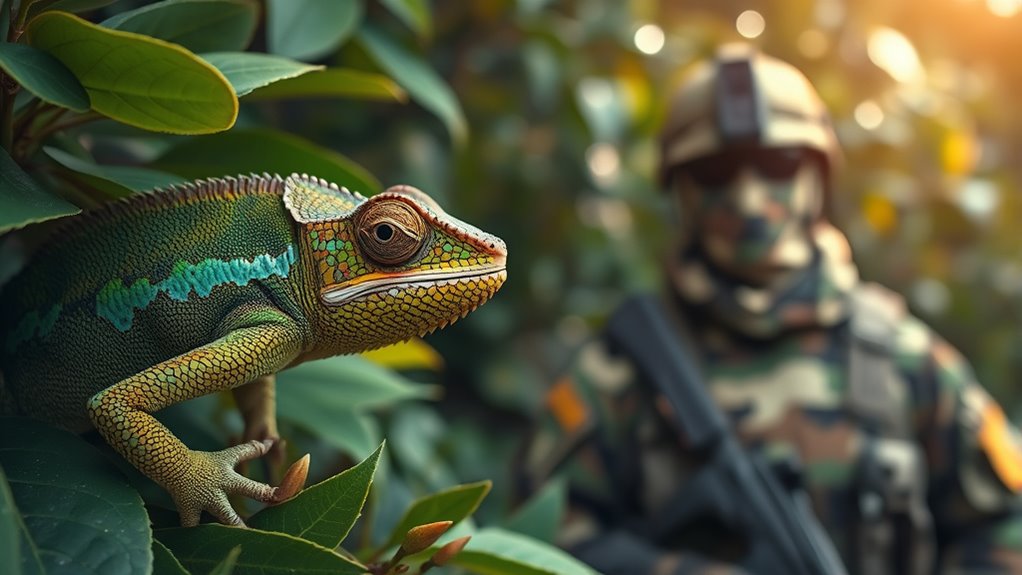
As the need for concealment grows in various fields, human applications of camouflage have evolved considerably, drawing inspiration from nature.
Animals often change their skin or body parts to blend seamlessly into their surroundings, and this concept has shaped modern designs. Military personnel and hunters wear specialized camouflage clothing, like ghillie suits, that mimic local foliage and textures.
Historically, the British Army first adopted khaki uniforms to reduce visibility in deserts. During World War I, Razzle Dazzle camouflage used bold patterns to confuse enemies about the direction of ships.
Today, advancements in materials and designs enhance concealment, optimizing strategies for both tactical missions and recreational activities. This ongoing evolution showcases our deep connection to nature's clever adaptations, reflecting how risk assessment plays a crucial role in developing effective camouflage for various applications.
Mechanisms of Color Production and Change

When you explore how animals produce color, you'll notice two main mechanisms at play: biochromes and structural coloration.
Biochromes involve natural pigments that create colors chemically, while structural coloration relies on microscopic structures to refract light.
Understanding these mechanisms helps you appreciate the fascinating ways animals adapt their appearance for survival.
Biochromes and Pigment Production
Biochromes play an essential role in how animals produce and change color, influencing their survival and interactions in the environment.
These natural pigments, like melanins and carotenoids, generate distinct colors through chemical processes, with melanins providing blacks and browns, while carotenoids yield yellows and reds.
Chromatophores, specialized cells containing these pigments, allow rapid color changes by expanding or contracting. This adaptability is vital for camouflage, as seen in animals like the Arctic fox, which alters its coat color seasonally for better concealment.
Additionally, iridophores, a type of chromatophore, reflect light to create iridescent colors, further enhancing an animal's ability to blend into its surroundings.
Hormonal or neural signals control these changes, ensuring effective camouflage and communication.
Structural Coloration Mechanisms
While many animals rely on pigments for color, structural coloration mechanisms create stunning hues through the manipulation of light. This phenomenon occurs when microscopic structures refract and scatter light, producing vibrant colors without pigments.
For example, blue jays and peacock feathers exhibit this striking effect. Iridophores, a type of specialized chromatophore, contain guanine platelets that reflect light, resulting in iridescent colors that shift based on your viewing angle.
These structural coloration mechanisms can be more stable and vivid than pigment-based colors, allowing for effective camouflage in various environments. Animals like the cuttlefish cleverly combine both pigment-based and structural coloration, adapting their appearance rapidly for camouflage and communication, highlighting the complexity of these mechanisms in nature.
Color Change Adaptations
Color change adaptations in animals showcase remarkable mechanisms that allow for rapid alterations in appearance, enhancing survival through camouflage and communication.
You'll find that various species utilize different methods to change their skin color and patterns:
- Chromatophores: Specialized cells that expand or contract, altering pigmentation.
- Melanocytes: Produce melanin in birds and mammals, allowing for dark colors.
- Carotenoids: Birds acquire these from their diet for vibrant yellows and oranges.
- Iridophores: Reflect light through microscopic structures for iridescence, enabling quick color shifts.
- Environmental triggers: Factors like UV light and temperature can initiate color changes for better camouflage.
These complex adaptations provide animals with the ability to blend seamlessly into their surroundings, ensuring their survival in diverse environments.
Evolution and Adaptation of Camouflage
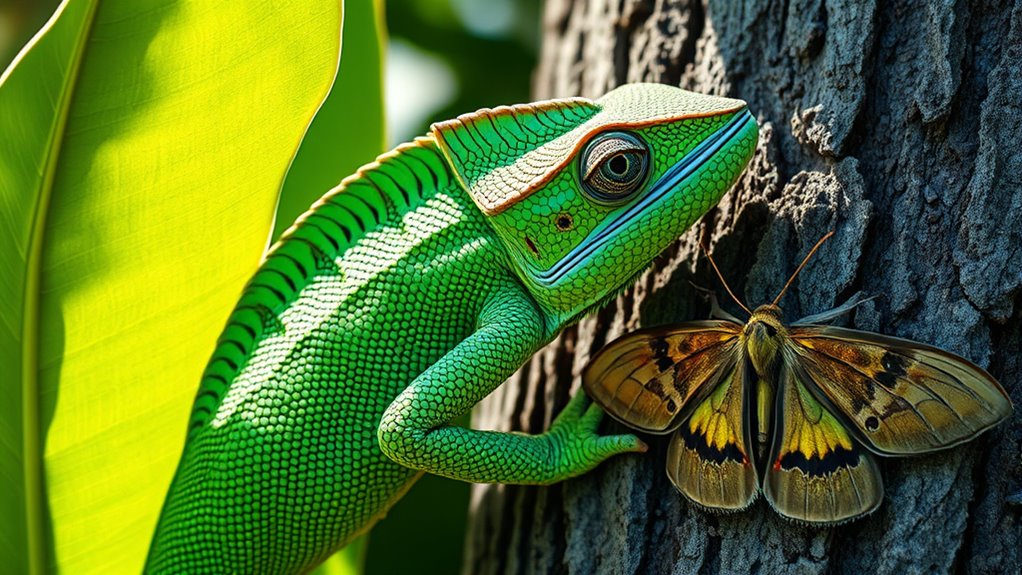
As species face the relentless pressures of their environments, the evolution of camouflage emerges as an essential survival strategy. Through natural selection, species develop adaptations that help them blend into their surroundings, improving their survival rates. For instance, reptiles and fish can alter their coloration thanks to living cell biochromes. This ability, though rare, is crucial for many species against predation and environmental changes. Evolutionary adaptations include background matching, disruptive coloration, and behavioral adjustments, showcasing the complex interplay within ecosystems.
| Adaptation Type | Description |
|---|---|
| Background Matching | Camouflage that mimics the habitat's colors. |
| Disruptive Coloration | Patterns that break up the outline of the animal. |
| Behavioral Adjustments | Changes in behavior to enhance concealment. |
| Seasonal Adaptations | Color changes based on seasonal variations. |
| Predator-Prey Dynamics | Continuous evolution between hunters and the hunted. |
Interesting Facts About Camouflage

Have you ever wondered how animals manage to evade predators so effectively? Camouflage is a fascinating strategy that allows them to blend into their environments.
Here are some interesting facts about how different animals use camouflage to alter their appearance:
- Chameleons change colors for camouflage, communication, and temperature regulation.
- The scarlet king snake mimics the venomous coral snake's colors for protection.
- A rhyme helps identify harmless versus harmful snakes based on their skin patterns: "Red on yellow kills a fellow, Red on black won't hurt Jack."
- Dresser crabs enhance their concealment by adorning their bodies with environmental materials.
- Militaries study animal adaptations to improve human camouflage techniques in modern warfare.
These examples show the incredible diversity and effectiveness of camouflage in the animal kingdom!
Frequently Asked Questions
What Is the Process of Animal Camouflage?
Animal camouflage is a fascinating process where creatures adapt their appearance to blend into their surroundings.
You'll notice that some animals change color or texture to match their environment, making it hard for predators or prey to spot them. This can happen through specialized cells that shift colors rapidly.
Seasonal changes also play a role, as animals might alter their coats to stay concealed, ensuring their survival in different habitats.
What Is the Scientific Name for Animal Camouflage?
Imagine a master illusionist, disappearing right before your eyes. The scientific name for this fascinating trick in the animal kingdom is "cryptic coloration."
It's all about how organisms adapt to their surroundings, blending seamlessly to avoid detection. You'll find that these clever strategies include background matching, disruptive coloration, and mimicry.
Each method not only enhances concealment but also showcases the remarkable ingenuity of nature in helping beings survive amidst their environments.
What Are the 4 Types of Animal Camouflage?
You'll find four main types of animal camouflage.
First, there's background matching, where animals blend into their environment.
Then, disruptive coloration uses bold patterns to break up outlines.
Next is mimicry, where one species resembles another to avoid predation.
Finally, warning coloration signals danger through bright colors, deterring predators.
Each type plays an essential role in survival, helping animals evade threats in their natural habitats.
What Is the Theory of Camouflage?
Did you know that around 80% of all animals use some form of camouflage? The theory of camouflage explains how organisms adapt their colors and patterns to blend into their environments, making them less visible to predators or prey.
This adaptation involves techniques like background matching and disruptive coloration. Fundamentally, it's all about survival, as those that successfully conceal themselves are more likely to thrive and pass on their genes.
Conclusion
So, while you might think you're the master of disguise at your next costume party, remember that nature's been perfecting camouflage for millions of years. From chameleons to cuttlefish, these creatures blend into their surroundings with a finesse that puts any human costume to shame. Ironically, it's not just about hiding; it's about survival. Next time you spot a cleverly hidden animal, you might just find a lesson in nature's artistry that's far more impressive than your outfit!
